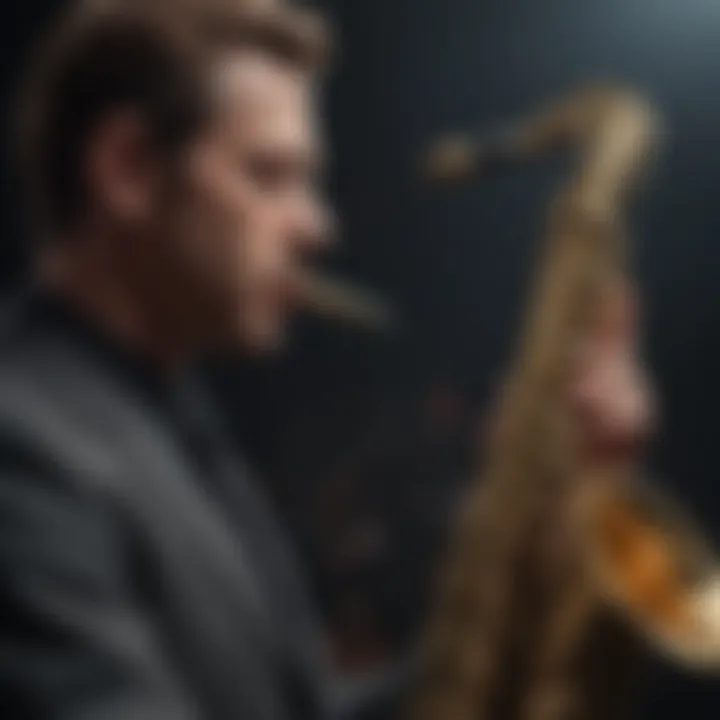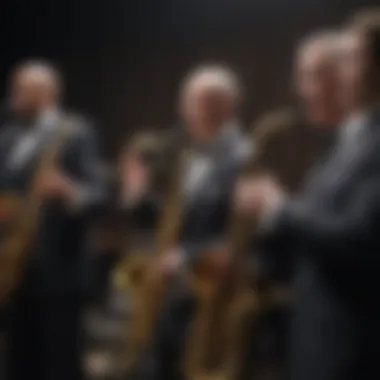Exploring the Best of Jazz Artists: An In-Depth Examination


Intro
Jazz music has long served as a reflection of cultural evolution and musical creativity. From its roots in the early 20th century to the contemporary masterpieces of today, jazz has proven to be dynamic. The exploration of its vast contributions demands a look at the artists who have shaped it. This article will provide an in-depth examination of various influential jazz musicians, emphasizing their unique styles, contributions, and lasting impact on the genre.
By dissecting the essence of iconic figures alongside modern innovators, readers will appreciate not only the music itself but also the rich narratives that accompany each artist’s journey.
Artist Profile
Understanding an artist’s essence involves more than just analyzing their music. Their background, personal experiences, and influences all play significant roles in their creative expression. In this section, we will delve deeper into the biographies and motivations of select jazz artists.
Biography and Background
Jazz artists come from diverse backgrounds, each bringing unique perspectives to the genre. For example, Louis Armstrong, born in New Orleans, was a pioneer who was instrumental in popularizing jazz in America. Similarly, Billie Holiday’s early struggles influenced her emotive vocal style.
These artists often faced considerable challenges, including societal barriers and personal hardships. Such experiences frequently fueled their passion for music.
Major Influences and Inspirations
Many jazz musicians cite various genres and avant-garde movements as sources of inspiration. For instance, Charlie Parker was deeply influenced by the harmonic complexity of classical music, while Miles Davis explored the realms of rock, funk, and even electronic music during his career.
This interplay of musical styles not only highlights jazz's versatility but also shows how artists responded to the world around them. Some prominent influences may include:
- Gospel music
- Blues
- Classical compositions
- Cultural movements
Song Analysis
Analyzing specific songs can reveal much about an artist’s style and intent. This section looks at key tracks that define jazz and providing rich lyrical and instrumental detail.
Theme and Lyrics Breakdown
The themes prevalent in jazz songs often address complex emotions and social issues. Take, for example, "Strange Fruit," performed by Billie Holiday, which addresses racial violence through haunting lyrics. Each line articulates a profound sense of grief and poignant reflection, revealing the depth at which jazz can engage with societal issues.
Instrumentation and Composition
Instrumentation in jazz is typically diverse and ever-evolving. Instruments like the saxophone, trumpet, and piano often define a piece’s character. In this context, it’s crucial to recognize how composers weave these elements into their work. For example, John Coltrane's "Giant Steps" features a groundbreaking approach to chord progressions that has influenced countless musicians.
Understanding the compositional choices behind notable jazz tracks allows listeners to appreciate the intricate craftsmanship that characterizes the genre.
"Jazz is an ever-evolving art form that reflects the complexities of society and the creativity of humanity."
In summary, jazz remains a critically relevant musical genre. By examining the profiles of its significant artists and analyzing their best works, we can deepen our understanding of the influences that shape jazz and appreciate its ongoing evolution.
Prelude to Jazz
Jazz is a uniquely vibrant genre that has given voice to countless artists across decades. It embodies a rich tapestry of rhythm, harmony, and improvisation that speaks to the intrinsic human experience. Understanding jazz requires delving into its historical roots and its defining characteristics. This section aims to provide a foundational perspective on jazz, essential for appreciating the influential artists discussed later in this article.
Historical Context
The historical foundation of jazz is pivotal in understanding its evolution and significance. Emerging in the late 19th and early 20th centuries, jazz grew from the convergence of African musical traditions, blues, and ragtime. Cities like New Orleans became breeding grounds for this new musical expression. The African American community played a crucial role in shaping jazz, infusing it with cultural elements and spiritual depth.
In the early days, jazz was often played in clubs and social gatherings. It reflected the struggles and hopes of its creators. Major developments occurred through various decades, including the Harlem Renaissance, which marked an era of heightened creativity and expression. Artists began to gain recognition, and jazz became an influential part of American culture. The genre continued to evolve, giving rise to various styles, from bebop to free jazz, each reflecting the changing social landscape.
Core Characteristics of Jazz
The essence of jazz lies in its core characteristics, which distinguish it from other music genres. Here are several key elements:
- Improvisation: This is perhaps the most significant feature. Musicians often create melodies spontaneously, allowing for individual expression and creativity during performances.
- Syncopation: Jazz employs rhythmic flexibility. Accents occur on unexpected beats, creating a unique, swinging effect that is integral to its sound.
- Call and Response: This conversational style is rooted in African musical traditions. Musicians engage with each other through musical phrases, resulting in dynamic and interactive performances.
- Diverse Influences: Jazz is eclectic. It incorporates elements from various genres, including blues, classical, and rock. This adaptability contributes to its ongoing evolution.
"Jazz is about being in the moment. It is about creating a shared experience that is constantly evolving."
Defining Greatness in Jazz
Defining what makes an artist great within the jazz genre is no simple task. Jazz is a complex tapestry of styles, influences, and expressions. Greatness in jazz involves not only technical proficiency but also originality, emotional depth, and cultural impact. To truly appreciate the contributions of jazz artists, one must explore specific criteria for evaluation alongside understanding how these artists have influenced the genre itself.
Criteria for Evaluation
Greatness in jazz can be evaluated through several significant criteria:
- Technical Skill: This includes the artist's mastery of their instrument, vocal technique, or compositional skills. For example, Charlie Parker’s innovative saxophone techniques set a new standard for jazz musicians.
- Originality: Artists who introduce unique styles or concepts often leave a lasting impact. Miles Davis, for instance, revolutionized jazz through his work in both bebop and modal jazz, pushing boundaries that others would later follow.
- Emotional Resonance: Great artists create music that evokes strong emotions. Billie Holiday’s heartfelt delivery and personal storytelling resonate deeply with listeners, highlighting her emotional depth as an artist.
- Cultural Influence: Consider how artists address social issues or reflect their cultural backgrounds in their music. Nina Simone used her platform to engage in civil rights discourse through powerful songs, bridging jazz with important cultural movements.
By examining these criteria, one can appreciate why certain artists are celebrated not just for their sound, but for their broader contributions to the jazz landscape.
Influence on Genre
The influence of various artists on former generations and the genre itself cannot be overstated. Some key points include:
- Pioneers of Style: Artists like Louis Armstrong and Duke Ellington reshaped the direction of jazz, with Armstrong focusing on improvisation and personal expression, while Ellington expanded jazz into orchestral territory.
- Generational Impact: Musicians often draw inspiration from the greats who came before them. For instance, artists like Kamasi Washington incorporate historic jazz elements into contemporary contexts, creating a bridge between past and present.
- Subliminal Education: Many jazz musicians are self-taught or have learned by listening to records. This passing of knowledge and innovation creates a continuous evolution of the art form.
The evolution of jazz is a dynamic process, heavily influenced by each artist's willingness to redefine boundaries and innovate.
In essence, the greatness of an artist in jazz is multifaceted, extending beyond mere technical skill to encompass originality, emotional depth, and lasting cultural impact. This evaluation allows us to appreciate the musicians who not only played the music but also shaped its future.
Foundational Jazz Artists
The examination of foundational jazz artists is vital to understanding the evolution and richness of jazz music. These artists did not merely contribute sounds; they created entire new paradigms of musical expression that shaped the genre. By investigating their contributions, one gains an appreciation for jazz's complexity and its capacity for innovation and emotional depth. These foundational figures set the stage for future generations of musicians, providing a blueprint that is still influential today.
Louis Armstrong
Early Life and Career
Louis Armstrong was born in New Orleans in 1901. His early life was marked by poverty, yet music provided him with an escape and a future. Armstrong began playing the cornet in a home for troubled boys, where he developed his talent. His career took off when he joined the King Oliver's Creole Jazz Band. This experience honed his skills in performance and improvisation.
Armstrong's upbringing profoundly impacted his music. The blend of African American musical traditions he encountered in New Orleans laid the groundwork for his unique style. His ability to convey emotion through music is one of the key characteristics that made him a pivotal figure in jazz. The invaluable insights into the cultural context of his development make his story a beneficial choice in discussing foundational artists.


Musical Innovations
Louis Armstrong is renowned for his innovative approach to jazz. He introduced the concept of scat singing, a vocal style where nonsensical syllables are used in place of lyrics, emphasizing the improvisational aspect of jazz. His virtuosic trumpet playing established new standards for technique and expression.
What sets Armstrong apart is his ability to swing, transforming rhythms and melodies into something unique and compelling. His innovations continue to resonate within jazz and beyond, further solidifying his influence. The advantages of highlighting Armstrong's musical innovations lie in the insight they provide into how jazz evolved and why it is regarded as a sophisticated art form.
Legacy
Armstrong's legacy extends far beyond his music. He helped to bring jazz to a broader audience, breaking racial barriers and showcasing the power of artistic expression. This influence is characterized by his ability to communicate deep feelings and narratives through music.
Furthermore, his work has inspired countless musicians, establishing a lineage of jazz artists who explore similar themes of improvisation and emotional truth. Armstrong's legacy is a beneficial element to discuss in this article, as it illustrates the intertwining of personal experience and musical innovation, encouraging future artists to explore their unique voices.
Duke Ellington
Orchestral Style
Duke Ellington emerged as a pivotal figure in jazz during the early 20th century. His orchestral style distinguished him from many of his contemporaries. Ellington's arrangements, often lush and complex, showcased the talents of his band members, turning the orchestra into a versatile instrument.
The key characteristic of Ellington's work is his ability to blur the lines between jazz and classical music. By incorporating elements from various genres, he created a sound that was sophisticated yet accessible. The uniqueness of his orchestral style enhances understanding of how jazz can evolve while honoring its roots.
Key Compositions
Ellington's catalog includes timeless compositions such as "Take the 'A' Train" and "Mood Indigo." These works highlight his remarkable talent for melody and sophistication in composition. Each piece is crafted with intricate harmonies and rhythms that challenge musicians and delight audiences.
The benefit of analyzing Ellington's key compositions lies in showcasing the artistic depth of jazz. His works remain essential listening for both fans and aspiring musicians, demonstrating that jazz is not just performance-based but also deeply rooted in compositional excellence.
Cultural Impact
Duke Ellington's cultural impact resonates strongly within both the music industry and American history. His music often addressed social issues and sought to elevate African American culture through art. Ellington's performances at prominent venues like the Cotton Club brought jazz into the mainstream, making it a significant cultural force.
The examination of his cultural impact underscores the importance of art in social commentary and the legacy of jazz as a reflective medium for societal change. This dimension of Ellington's influence provides insight into the broader roles that jazz musicians can play in culture and politics, offering a profound understanding of their contributions.
Charlie Parker
Bebop Pioneer
Charlie Parker revolutionized jazz in the 1940s with the development of bebop. This style emphasized complex harmonies and speed, distinguishing it from earlier jazz forms. Parker, along with others, redefined what jazz could be, moving it towards a more sophisticated and cerebral art form.
The significance of Parker as a bebop pioneer lies in his contributions to the vocabulary of jazz. He introduced new scales and improvisation techniques that are still studied today. Highlighting his role in this movement is beneficial, as it showcases the evolution of rhythms and melodies in jazz history.
Technique and Innovation
Parker's technical prowess was extraordinary, characterized by intricate melodies and rapid tempos. His improvisation was not just about playing fast; it was about creating unique musical phrases that challenged norms.
His innovative approach to melody and rhythm opened new possibilities for jazz musicians. This distinctive technique encouraged future artists to expand their creative boundaries. The advantages of discussing Parker's technique lie in the understanding of jazz as an art form that thrives on creativity and personal expression.
Influence on Future Generations
The influence of Charlie Parker extends to countless musicians who followed him. His work laid the groundwork for modern jazz, inspiring artists like Miles Davis and John Coltrane. Parker's style and techniques have become foundational elements in jazz education.
The emphasis on his influence illustrates how jazz is a living tradition, constantly evolving through new interpretations. Discussing Parker's impact provides insight into the connections between generations of musicians and the ongoing development of jazz as a dynamic genre.
Signature Styles and Their Artists
Signature styles in jazz are crucial for understanding the genre's evolution and diversity. Each artist brings a unique flavor to the music, reflecting personal experiences, cultural backgrounds, and innovative approaches. This section examines how different jazz styles emerged and the talented musicians associated with them. By analyzing signature styles, we can appreciate the layers and dimensions that jazz has to offer. These elements are not only informative but also enhance the musical dialogue between artists and audiences, providing insight into the complexities of jazz as a living art form.
Bebop and Beyond
Influential Figures
The Bebop movement redefined jazz, introducing a complexity that shifted the genre's focus from danceable melodies to intricate improvisation. Key figures like Charlie Parker and Dizzy Gillespie stand out for their contributions. Parker’s fast-paced improvisation pushed boundaries, while Gillespie's unique trumpet sound and style showcased the vibrant, unconventional spirit of Bebop.
The key characteristic of these influential figures is their technical mastery combined with emotional depth. Their music is often praised for its speed and complexity, making it an essential area of study for musicians and enthusiasts alike. The unique feature is the level of improvisation they introduced, providing more freedom in the creative process. This has a beneficial impact as it encourages aspiring musicians to explore their own voice and style within jazz.
Characteristics of Bebop
Bebop's characteristics include fast tempo, complex chord progressions, and intricate melodies. It often features smaller ensembles, which allows for more detailed conversations between musicians. The emphasis on improvisation means musicians must be highly skilled in order to adapt to sudden changes in music.
One key characteristic is the use of extended chords and intricate harmonies. This complexity is popular among musicians looking to challenge themselves and push the boundaries of jazz. The unique feature of this style is its focus on individual expression rather than danceability, which represents a significant shift in jazz history. This focus can be seen as advantageous for deepening one's musical understanding but may also pose challenges for those unfamiliar with jazz's technical aspects.
Cool Jazz
Notable Artists
Cool Jazz emerged as a counterpoint to the frenetic energy of Bebop, introducing a more relaxed and introspective approach. Artists such as Miles Davis and Chet Baker brought a refreshing calm to jazz through smooth melodies and sophisticated arrangements. This style is recognized for its harmonies and subtleties, which appeal to a broad audience.
The key characteristic of Cool Jazz is its emphasis on lyrical beauty and emotional expression. This makes it a beneficial choice for listeners seeking a more mellow jazz experience. Notable artists like Davis often explore intricate themes and emotions, providing profound listening opportunities. The unique feature of this style is its blending of classical elements with jazz, leading to advantages in attracting a more diverse audience.
Sound Innovations
Sound innovations in Cool Jazz often include softer dynamics, intricate arrangements, and a focus on ensemble performance. Unlike Bebop, which often highlights individual musicians, Cool Jazz celebrates the collective sound and interaction between players. This characteristic allows for a more harmonious musical experience.
The key characteristic of these innovations is their ability to create a seamless flow of music, which is popular among listeners who prefer smooth sounds. The unique feature is how these innovations contribute to a broader understanding of jazz, inviting more listeners into the genre. This advantageous aspect of Cool Jazz allows musicians to reach audiences who may find traditional jazz forms challenging.
Free Jazz
Key Proponents
Free Jazz emerged as a radical departure from established jazz norms. Figures like Ornette Coleman and Cecil Taylor championed this unpredictable and avant-garde form of jazz. Their willingness to experiment with structures and forms pushed the boundaries of what jazz could be.
The key characteristic of these proponents is their commitment to artistic freedom. This aspect makes it a popular choice for those seeking innovation and new musical expressions. The unique feature of Free Jazz is its rejection of traditional scales and rhythms, offering a benefit in expanding the boundaries of the genre. However, this can also be a disadvantage for those who prefer conventional forms of jazz.
Philosophy of Freedom in Jazz
The philosophy of freedom in jazz emphasizes improvisation, self-expression, and breaking away from established conventions. This ideology allows musicians to explore their creativity fully. Coleman, for example, advocated for personal expression above all else, influencing generations of artists.


The key characteristic of this philosophy is its emphasis on individual interpretation and the rejection of rigid structures. This makes it a beneficial perspective for aspiring musicians who want to develop their unique voices. The unique feature of this philosophy is its ability to foster creativity and diversity within jazz, presenting an advantage for innovation. However, this can also become a disadvantage for those who prefer more structured compositions.
Notable Contemporary Jazz Artists
Contemporary jazz artists play a crucial role in shaping the genre's future. They blend traditional elements with modern influences. This fusion of styles ensures that jazz remains relevant and dynamic. By examining notable contemporary artists, we can appreciate their contributions and unique sounds. Each artist brings a fresh perspective that enriches the overall landscape of jazz.
Esperanza Spalding
Musical Background
Esperanza Spalding's musical background showcases her early exposure to diverse genres. Born in Portland, Oregon, she began playing the violin at a young age. Spalding's multicultural heritage influences her style. She fuses jazz with elements of soul and R&B, making her sound distinctive. This blend attracts a wide audience, which is beneficial for this article. Her multifaceted background adds depth to the discussion of contemporary jazz. It enhances understanding of how musicians can draw from various influences.
Achievements
Spalding's achievements are impressive and noteworthy. In 2011, she won a Grammy Award for Best New Artist. This recognition was significant as it marked a milestone for jazz in mainstream music. Her ability to cross genres has expanded her reach and impact. These characteristics make her a key figure in contemporary jazz. Spalding's success demonstrates how genre boundaries can be transcended, emphasizing her relevance in today's musical landscape.
Innovative Sound
The innovative sound of Esperanza Spalding sets her apart from her peers. She often integrates elements of classical and experimental music into her compositions. This approach challenges conventional jazz norms. The unique features of her music create fresh listening experiences. Her sound is both progressive and rooted in tradition, enhancing the discourse about modern jazz. This duality makes it relevant for a wide audience, illustrating the evolution of jazz.
Kamasi Washington
Debut and Impact
Kamasi Washington made a profound impact with his debut album, "The Epic." Released in 2015, it received critical acclaim. The album's sweeping orchestration and deep spiritual themes resonated with listeners. This characteristic aligns with the article's goal to highlight influential contemporary artists. Washington's work revitalized interest in jazz among younger audiences, illustrating the genre's power to attract diverse listeners.
Cross-Genre Collaborations
Washington has collaborated with artists from various genres, including hip-hop and classical music. His work with Kendrick Lamar on "To Pimp a Butterfly" is particularly notable. Such collaborations broaden the audience for jazz, making it more accessible. The blend of styles showcases the adaptability of jazz. This aspect is critical for understanding its continued relevance. His collaborations highlight how contemporary artists merge genres, which is important for our examination of jazz.
Robert Glasper
Fusion of Genres
Robert Glasper is renowned for his fusion of genres, particularly jazz and hip-hop. His ability to blend these styles has led to innovative and engaging music. This fusion benefits the article by illustrating how jazz evolves. Glasper's work appeals to listeners who may not usually engage with traditional jazz. His unique sound pushes creative boundaries, making it a crucial point in our exploration of contemporary jazz artists.
Significant Works
One of Glasper's significant works is the album "Black Radio." It showcases his blend of jazz with R&B and hip-hop elements. This unique feature reinforces the necessity of examining modern jazz releases. Glasper's albums often receive accolades for their originality. They attract attention within and beyond the jazz community. This aspect cements Glasper’s importance in understanding contemporary jazz's trajectory.
The Role of Women in Jazz
Women have played an instrumental role in shaping the landscape of jazz throughout its history. Their contributions span various eras and styles, challenging gender norms in a predominantly male-dominated genre. This section illuminates the pivotal roles that female artists have held, showcasing both trailblazers of the past and significant contributors of the present.
Trailblazers
Billie Holiday
Billie Holiday, known for her distinct vocal style and emotive delivery, brought a deep emotional resonance to jazz. Her ability to convey pain and joy in a singular moment has made her a lasting icon. Holiday’s song "Strange Fruit" stands as a powerful protest against racism, blending art and activism with profound effect. Such a choice makes her a beneficial inclusion, as it highlights the intersection of music and social issues in her work.
The uniqueness of Holiday lies in her phrasing and ability to bend notes, giving her songs a deeply personal touch. This characteristic sets her apart and emphasizes her influence on later jazz singers and genres, although her troubled life also serves as a cautionary tale about the toll of fame.
Ella Fitzgerald
Ella Fitzgerald is often hailed as the "First Lady of Song," and her scat singing remains a prominent feature of her legacy. Her pitch-perfect voice and inventive improvisation skills established her as a role model for jazz vocalists. Fitzgerald's extensive repertoire allowed her to traverse many musical styles, showcasing her versatility. This versatility makes her a compelling figure relevant to the discussion of women in jazz, offering an example of how talent can transcend genre boundaries.
Her ability to convey emotion through her vocal techniques is robust. This feature allows audiences to connect with her music on a deeper level, providing a clear advantage in her lasting impact within the genre, but it also raises the question of accessibility for aspiring singers aiming to reach her level of mastery.
Nina Simone
Nina Simone stands out for her combination of jazz with classical music influences and because of her involvement in civil rights activism. Tracks like "Feeling Good" and "Mississippi Goddam" not only highlight her vocal prowess but also her commitment to social justice. Her key characteristic as a socially conscious artist makes her inclusion crucial in conversations around the political dimensions of jazz.
Simone's unique approach blends genres, providing fresh perspectives within jazz music. This versatility offers various interpretations, inviting listeners to engage with social issues on multiple levels. However, her complexity also means that her music can be polarizing, as it challenges listeners to grapple with uncomfortable historical truths.
Modern Contributions
Terri Lyne Carrington
Terri Lyne Carrington is known for her work as a drummer and bandleader, offering a fresh voice in contemporary jazz. Her Grammy-winning album "The Mosaic Project" emphasizes collaboration among women in music, contributing to a growing recognition of female talent in jazz. Her innovative productions demonstrate the evolution of jazz while bringing necessary attention to gender dynamics within the genre.
The distinctiveness of Carrington's style involves blending traditional jazz with modern influences, bridging the gap between old and new. This aspect provides advantages for students and emerging musicians looking into the contemporary jazz landscape, although it may alienate purists who prefer more traditional forms.
Tina Weymouth
Although she is primarily known as the bassist for the Talking Heads, Tina Weymouth's influence extends into jazz through her distinctive rhythms and improvisational prowess. Her work showcases the importance of bass in jazz, traditionally an overlooked aspect in highlighting women musicians. Weymouth's fusion of rock and jazz illustrates the fluidity of genres, making her a popular choice for this article in discussing modern contributions.
Her innovative approach to bass guitar allows for new interpretations and serves as an inspiration for women in music. However, some may view her genre-blending as a departure from traditional jazz, which poses challenges when analyzing her contributions within this focused context.
écile McLorin Salvant
Cécile McLorin Salvant has garnered acclaim for her ability to blend classic jazz with personal storytelling. Her unique voice and bold artistic choices have brought a new perspective to jazz interpretation. Salvant's choice of material includes lesser-known tunes, shedding light on the heritage of jazz while ensuring its relevance. This aspect makes her an invaluable figure in contemporary discussions of jazz evolution.
The combination of her innovative approach and respect for jazz tradition provides a platform for new artists to explore. However, her avant-garde methods may not resonate with traditional jazz audiences, presenting a contrast that both excites and challenges perceptions.
Jazz is a continuous dialogue. The voices of women help shape this conversation, revealing the genre's past while steering its future.
The Evolution of Jazz
The evolution of jazz is a fundamental aspect of understanding the genre as a whole. It captures the dynamic transformation that jazz music has undergone since its inception. This section will elaborate on significant milestones and cross-cultural influences that have shaped jazz into the multifaceted genre it is today. Recognizing these changes allows musicians and enthusiasts alike to appreciate the rich history and cultural tapestry that forms the foundation of jazz music.
Historical Milestones
Several historical milestones mark the journey of jazz, each contributing uniquely to its development. The origin of jazz can be traced back to African American communities in New Orleans in the late 19th and early 20th centuries. This period saw the fusion of various musical styles, including blues, ragtime, and brass band traditions.


Some key developments include:
- 1910s: The rise of Dixieland, characterized by collective improvisation and a lively swing beat. Artists like Louis Armstrong and Jelly Roll Morton brought this style to the forefront.
- 1920s: The Jazz Age flourished, bringing jazz into mainstream culture. The introduction of phonograph records allowed for widespread dissemination of jazz music, influencing a generation.
- 1940s: The emergence of bebop, led by figures such as Charlie Parker and Dizzy Gillespie, shifted the focus to more complex rhythms and harmonies, attracting skilled musicians.
- 1960s and beyond: The diversity of jazz expanded through free jazz and fusion, integrating elements of rock and funk. Artists like Ornette Coleman and Miles Davis were at the forefront, redefining the boundaries of jazz.
These milestones have cemented jazz’s place in the music world, illustrating its ability to adapt and evolve continually.
Cross-Cultural Influences
Jazz is not merely an American art form; it is a global phenomenon influenced by diverse cultures. Throughout its history, jazz has drawn on various musical traditions, weaving a complex tapestry of sounds and styles. This cross-pollination has enriched jazz in ways that make it remarkably versatile.
Several notable cross-cultural influences include:
- African Rhythms: The roots of jazz in African American communities reflect the African rhythmic patterns and call-and-response techniques, which remain foundational in modern jazz.
- Latin Music: The incorporation of Afro-Cuban rhythms in genres like mambo and bossa nova brought fresh tempos and feels, enhancing jazz's rhythmic complexity.
- European Classical Music: Many jazz musicians have integrated elements of classical music, such as orchestration and harmonic structures, demonstrating jazz's ability to transcend cultural boundaries.
- Asian Influences: Artists like Vijay Iyer have begun to incorporate Indian classical music into their jazz compositions, showcasing the ongoing evolution through globalization.
Jazz represents a meeting point of cultures, echoing history and the shared human experience through sound.
Understanding these influences is critical for any aspiring musician or music student, as it underscores the genre's inherent ability to adapt and absorb new forms, ensuring its future vitality and relevance.
Jazz Festivals and Their Significance
Jazz festivals play a crucial role in the cultural landscape of jazz music. They serve as platforms for both established and emerging artists, allowing for the exploration of different styles, collaborations, and innovation within the genre. Festivals not only celebrate the music but also foster a sense of community among musicians and audiences alike. The vibrancy of a jazz festival often echoes the diverse influences and historical contexts intrinsic to the genre itself.
Moreover, these events provide opportunities for musicians to gain exposure and connect with fans who are passionate about jazz. For many artists, performing at a reputable festival can significantly enhance their career trajectory. It can lead to new collaborations, recording opportunities, and increased visibility in the jazz community.
Two key elements underpin the significance of jazz festivals:
- Cultural Exchange: Festivals often feature artists from various backgrounds, encouraging a rich exchange of musical ideas and traditions.
- Audience Engagement: They create a setting where listeners can immerse themselves in the art, often accompanied by workshops and panels to deepen their understanding of the music.
By attending festivals, enthusiasts witness firsthand the evolution of jazz and its interactions with other musical forms. This connection with the music is invaluable, enhancing appreciation for the genre as a whole.
Key Global Festivals
Across the world, numerous jazz festivals attract significant attention each year. Each festival has its unique flavor, often reflecting the local culture while showcasing a wide array of talent. Some of the most notable include:
- Montreux Jazz Festival (Switzerland): Established in 1967, it has grown into one of the most prestigious music festivals globally, attracting a diverse lineup of jazz legends and contemporary artists.
- Newport Jazz Festival (USA): This historic festival has showcased incredible talent since 1954 and is known for its stunning setting on the banks of the ocean in Rhode Island.
- North Sea Jazz Festival (Netherlands): It claims to be the largest indoor music festival globally, featuring over 1,600 musicians and multiple genres, primarily jazz.
- Cape Town International Jazz Festival (South Africa): Known for its dedication to highlighting African talent, this festival has become a focal point for jazz in Africa.
These festivals exemplify the global reach and enduring appeal of jazz, uniting diverse audiences and artists in celebration of the genre.
Impact on Artists and Audience
The impact of jazz festivals on artists cannot be understated. They offer a stage where musicians can showcase their work to larger audiences, often leading to meaningful artist-audience interactions. This exposure is essential, particularly for up-and-coming musicians striving to establish themselves in a competitive industry.
For audiences, festivals provide an immersive experience. Listeners engage with live performances in a way not possible through recorded music. The spontaneity of live jazz creates an electric atmosphere that resonates deeply with fans.
Furthermore, festivals often feature educational components that allow attendees to learn more about jazz's history and its various styles. Workshops, masterclasses, and artist talks contribute to a richer understanding of the music, making even casual listeners more informed and appreciative.
"Jazz festivals not only launch careers; they expand horizons for audiences, allowing a unique cultural dialogue to flourish."
Analyzing Iconic Jazz Albums
Analyzing jazz albums is crucial for understanding the evolution of the genre and its cultural relevance. Each album serves as a snapshot of its time, contributing to the larger narrative of jazz history. By studying these works, listeners can appreciate the progression of styles, techniques, and innovations that define jazz music. This analysis extends beyond mere enjoyment; it enriches the listener's comprehension of the genre's complexity.
Milestones in Jazz Recording
Several albums are considered milestones in jazz recording, marking significant advancements in musical expression and production techniques. For example, "Kind of Blue" by Miles Davis, released in 1959, is often hailed as one of the greatest jazz recordings of all time. Its modal jazz approach broke traditional harmonic constraints and influenced countless musicians. The album's improvisational nature invites listeners to explore the nuances of each performance.
Another pivotal work is "A Love Supreme" by John Coltrane. This suite from 1965 blends spiritual themes with innovative structure, showcasing Coltrane's remarkable ability to convey emotion through music. It is not just an album but a transformative experience that challenged conventional jazz forms. Such milestones underline the importance of context in the appreciation of jazz, illuminating how the art form continues to push boundaries.
Contemporary Releases Worth Noting
Contemporary jazz continues to evolve, often blending different genres and reflecting modern themes. "Blackstar" by David Bowie, while primarily a rock album, features significant jazz elements and was shaped by jazz musicians like Donny McCaslin. This fusion exemplifies how contemporary artists draw inspiration from jazz to create innovative music.
Additionally, "Heaven and Earth" by Kamasi Washington represents a modern approach to jazz, where elements of hip-hop, classical, and soul intersect, showcasing Washington’s versatility. These contemporary albums not only highlight the ongoing relevance of jazz but also attract newer generations to the genre.
Understanding the significance of both landmark and contemporary albums is essential for any music enthusiast or student wanting to grasp the full scope of jazz's artistic journey. Each release adds to a rich tapestry that reflects cultural shifts and personal expressions.
The Intersection of Jazz and Technology
The exploration of jazz has continuously evolved, and one of the most significant forces propelling this transformation is technology. Today, the intersection of jazz and technology is more visible than ever, shaping how music is created, shared, and experienced. This section will delve into the influence of digital media and innovations in recording and production, both of which are pivotal in understanding contemporary jazz.
Influence of Digital Media
Digital media has revolutionized the music industry, providing jazz artists with unprecedented platforms for expression and distribution. In the realm of jazz, platforms like Spotify, Apple Music, and SoundCloud have become essential tools for musicians. These services not only allow artists to distribute their work globally but also enable them to connect with audiences directly. The accessibility of streaming has democratized jazz, making it easier for independent artists to reach listeners without relying on traditional record labels.
Moreover, social media platforms, such as Facebook and Instagram, facilitate engagement between artists and fans. Musicians can share their creative processes, promote upcoming gigs, and even live stream performances. This interaction fosters a sense of community within the jazz genre, allowing fans to connect more deeply with the artists they admire.
"The advent of digital media has transformed not just how music is consumed, but also how it is created and perceived."
Additionally, the rise of online education platforms has opened new avenues for learning jazz. Aspiring musicians can access lessons from seasoned professionals worldwide, expanding their understanding of this complex genre. This shift has encouraged diversity in jazz styles, as musicians from various backgrounds and cultures can now share their interpretations and innovations.
Innovations in Recording and Production
The innovations in recording technology have been equally influential in shaping modern jazz. From analog to digital recording, each advancement has brought new possibilities for sound manipulation and production quality. Tools such as Digital Audio Workstations (DAWs) like Ableton Live and Pro Tools allow artists to experiment with various sounds and recording techniques, ultimately pushing the boundaries of traditional jazz.
Producers and engineers now explore genres beyond jazz, fusing elements that create unique sounds. Artists like Robert Glasper exemplify this trend. His music, which blends jazz with hip-hop and R&B, showcases how modern production techniques can innovate the genre. Likewise, Kamasi Washington draws inspiration from various roots, utilizing technology to craft dense, cinematic compositions.
Furthermore, technology has enabled remote collaborations. Musicians from different parts of the world can now easily collaborate over the internet, breaking geographical barriers. They can exchange tracks and ideas in real-time, resulting in a rich tapestry of influences and styles that reflect a global jazz community.
In summary, the intersection of jazz and technology represents a dynamic and transformative experience. The influence of digital media has created new pathways for distribution and audience engagement, while innovations in recording have expanded the creative potential of jazz artists. As technology continues to evolve, one can anticipate even more exciting developments that will further enrich this ever-evolving genre.
Epilogue
The conclusion of this article serves to highlight the enduring significance of jazz artists and their contributions to music and culture. As an evolving genre, jazz continues to reflect and respond to the complexities of contemporary society. The influential figures discussed throughout the article illustrate how various styles and innovations have shaped not just musical landscapes, but also social movements and cultural dialogues.
Reassessing Jazz in Contemporary Culture
In today's world, jazz finds itself in a unique position. Its roots can be traced back over a century, and its relevancy is often reassessed in light of modern influences. The beauty of jazz lies in its adaptability. Modern artists remain committed to experimentation, infusing traditional elements with contemporary sounds. This includes the integration of technology in production and distribution, reaching new audiences.
Moreover, the presence of jazz in multimedia—such as film scores and digital streaming—highlights its versatility. It serves as a backdrop for storytelling, emotional expression, and artistic collaboration. This establishes jazz as not merely a genre, but as a living and breathing cultural force.
The challenges facing jazz today include competition with other popular music styles. However, the rich history and deep emotional resonance of jazz offer a distinct allure. As younger musicians embrace jazz, they bring fresh perspectives, ensuring that the genre continues to thrive. This evolution represents not just a survival mechanism, but rather an affirmation of its cultural weight.







